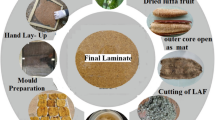Abstract
This paper studied the effect of the hybridization of carbon and Kevlar fibers on mode I interlaminar fracture toughness and crack propagation behaviors with double cantilever beam (DCB) tests. The crack propagation characteristics, crack growth trend and rate, and fracture surfaces were observed using an optical microscope and SEM micrographs for the three different types of materials. Moreover, details of the stress distribution around the crack tip and the crack propagation pattern across the width of the DCB specimen were investigated using the finite element method, including a cohesive element. The mode I interlaminar fracture toughness of carbon-Kevlar hybrid/epoxy was nearly average for carbon/epoxy and Kevlar/epoxy. The maximum load predicted by the numerical method showed good agreement within an error of 5% with the experimental results.
Similar content being viewed by others
References
Kim, J. S., Jung, J. C. and Lee, S. J., “A Study on the Bodies of Railway Vehicles for Hybrid Composite Materials,” J. of KSC, Vol. 18, No. 4, pp. 19–25, 2005.
Yoon, S. H., Heo, K. S., Jung, J. S., Kim, J. S. and Han, S. H., “A Study on Evaluation Technologies for Damage Tolerance under Mode I Transform in Composite Structure Materials for Tilting Vehicles,” J. of KSR, Vol. 8, No. 2, pp. 573–580, 2005.
Szekrényes, A. and Uj, J., “Comparison of Some Improved Solutions for Mixed-mode Composite Delamination Coupons,” Composite Structures, Vol. 72, No. 3, pp. 321–329, 2006.
Yang, I. Y., Jeong, J. Y. and Kim, J. H., “Fracture Toughness of CFRP Laminated Plates according to Resin Content,” Int. J. Precis. Eng. Manuf., Vol. 11, No. 2, pp. 309–313, 2010.
Suppakul, P. and Bandyopadhyay, S., “The Effect of Weave Pattern on the Mode-I Interlaminar Fracture Energy of E-glass/viny1 ester Composites,” Composites Science and Technology, Vol. 62, No. 5, pp. 709–717, 2002.
Gill, A. F., Robinson, P. and Pinho, S., “Effect of Variation in Fibre Volume Fraction on Mode I & II Delamination Behaviour of 5HS Woven Composites Manufactured by RTM,” Composites Science and Technology, Vol. 69, No. 14, pp. 2368–2375, 2009.
Ribicki, E. F. and Kanninen, M. F., “A Finite Element Calculation of Stress Intensity Factors by a Modified Crack Closure Integral,” Engineering Fracture Mechanics, Vol. 9, No. 4, pp. 931–938, 1977.
Camanho, P. P., Davila, C. G. and Ambur, D. R., “Numerical Simulation of Delamination Growth in Composite Materials,” NASA/TP-2001-211041, 2001.
Borg, R., Nilsson, L. and Simonsson, K., “Simulating DCB, ENF and MMB Experiments Using shell elements and a cohesive zone model,” Composites Science and Technology, Vol. 64, No. 2, pp. 269–278, 2004.
Diehl, T., “On using a penalty-based cohesive-zone finite element approach, Part I: Elastic solution benchmarks,” Int. J. of Adhesion & Adhesives, Vol. 28, No. 4–5, pp. 237–255, 2008.
Turon, A., Davila, C. G., Camanho, P. P. and Costa, J., “An Engineering Solution for using Coarse Meshes in the Simulation of Delamination with Cohesive Zone Models,” NASA/TM-2005-213547, 2005.
Alfano, G., “On the influence of the shape of the interface law on the application of cohesive-zone models,” Composites Science and Technology, Vol. 66, No. 6, pp. 723–730, 2006.
ASTM No. D5528-01, “Standard Test Method for Mode I Interlaminar Fracture Toughness of Unidirectional Fiber-Reinforced Polymer Matrix Composites,” 2001.
Author information
Authors and Affiliations
Corresponding author
Rights and permissions
About this article
Cite this article
Kim, SC., Kim, J.S. & Yoon, HJ. Experimental and numerical investigations of mode I delamination behaviors of woven fabric composites with carbon, Kevlar and their hybrid fibers. Int. J. Precis. Eng. Manuf. 12, 321–329 (2011). https://doi.org/10.1007/s12541-011-0042-7
Received:
Accepted:
Published:
Issue Date:
DOI: https://doi.org/10.1007/s12541-011-0042-7




